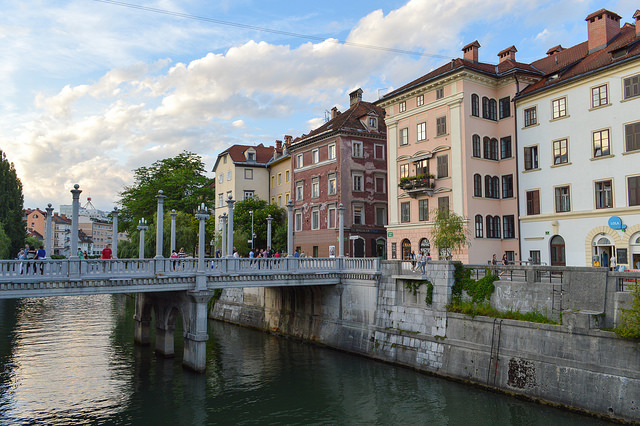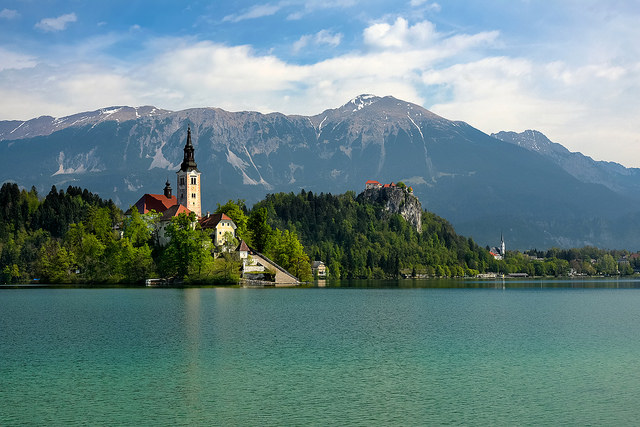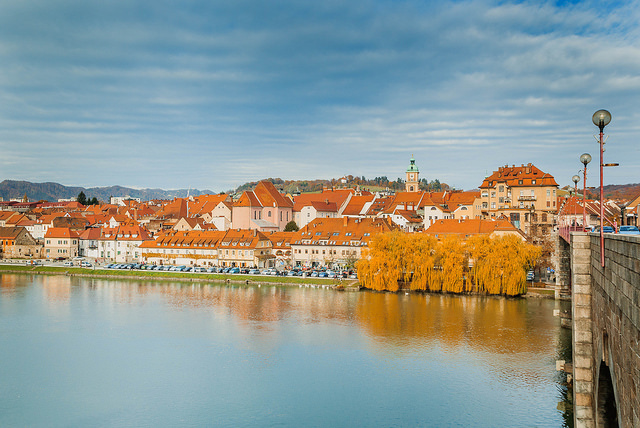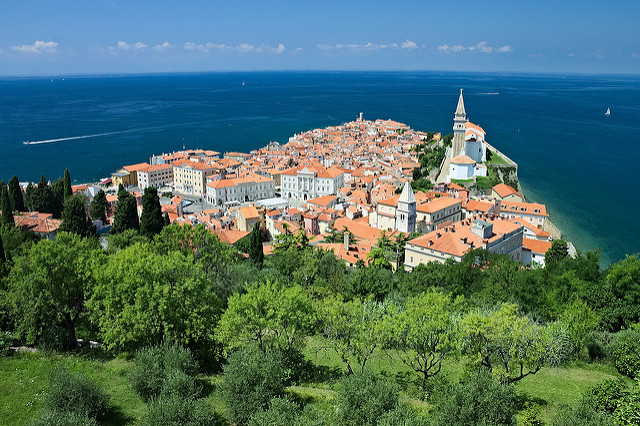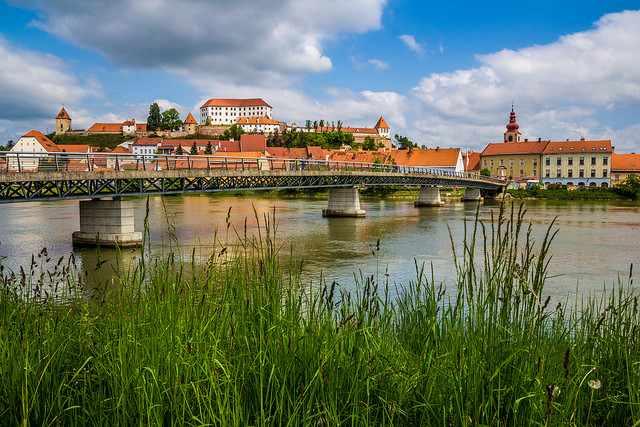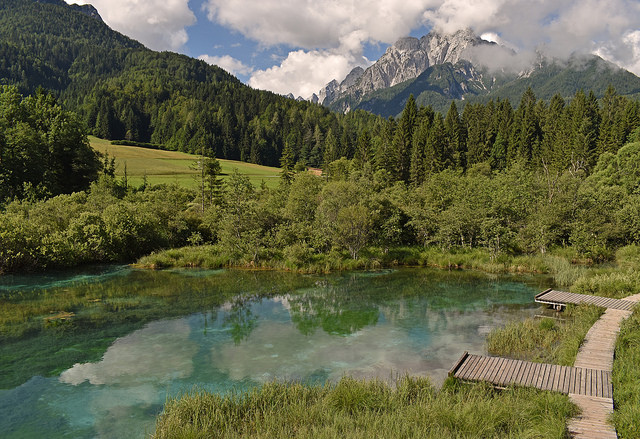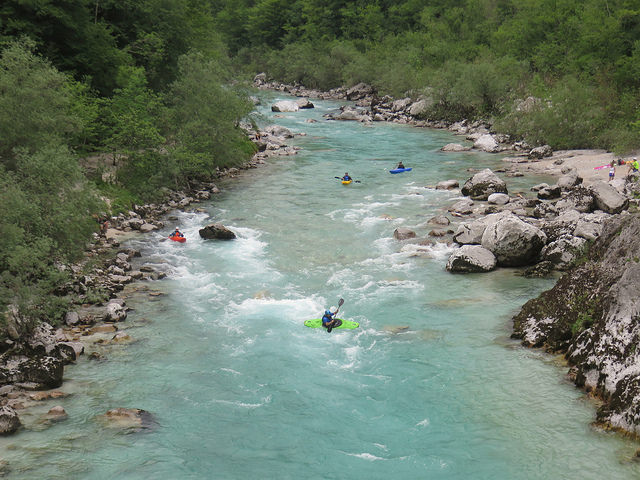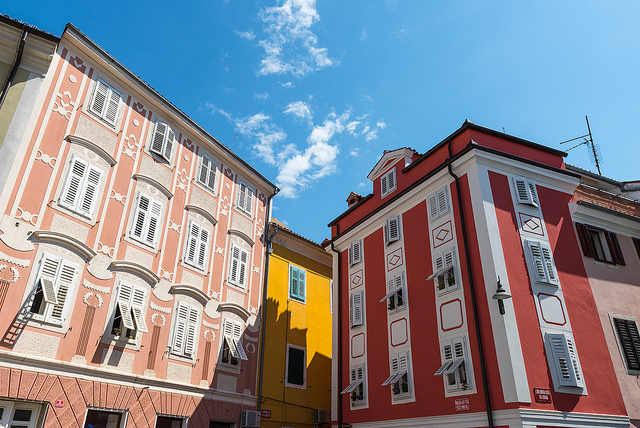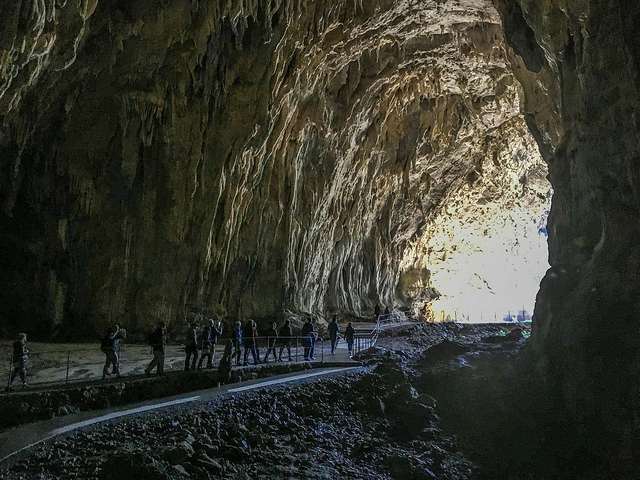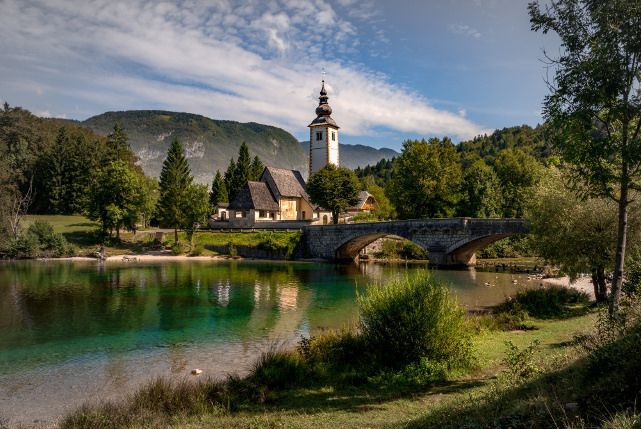
Ribčev Laz at Lake Bohinj, Slovenia. Bernd Thaller/Flickr
Spanning the Adriatic Sea to the Julian Alps, Slovenia packs stunning and diverse landscapes into a mere sliver of southern Central Europe. Bordered by Italy, Hungary, Croatia, and Austria, Slovenia sits at the crossroads of historical powers and cultures. The tiny country has been under the reign of the Roman Empire, the Habsburgs, the Kingdom of Serbia, and eventually the Socialist state of Yugoslavia before gaining independence in 1991. Today Slovenia is thriving, demonstrated by its recognition as the European green capital of 2016 for its sustainability initiatives. Check out the list of top destinations below to start planning your trip to this beautiful, underrated alpine gem.
Ljubljana
Slovenia’s capital, Ljubljana, is the largest and most dynamic city in the country. Though Ljubljana may be lacking in major attractions (many see this as a plus), the city draws visitors to stroll and enjoy its old town, cafés, and architecture. The summer offers the best weather and the lively Trnfest — a month-long, free festival in August featuring local and international artists and performers. The packed scheduled includes something for all ages: music, theater, dance, film, and educational workshops. Summer also sees the pedestrian street cafés at their most vibrant. For a birds-eye view of the action, rooftop café Nebotičnik grants stunning views of the cityscape. Ljubljana’s architectural gems can be appreciated any time of year, notably the Triple Bridge, Dragon Bridge, and Ljubljana Castle. The remarkable bridges span the meandering Ljubljanica river to connect the western new city with the eastern old city. The Old Town riverfront area hosts plenty of events during the holidays, including concerts, light displays, and a Christmas market. With easy train connections to rural Slovenia and nearby destinations such as Venice and Zagreb, Ljubljana makes as a great base or stop on a trip through southern Central Europe.
A Luxury Hotel Pick:
Lake Bled
Postcard-perfect Lake Bled is perhaps the most featured Slovenian destination in the travel industry. Though word about it is out, this stunning lake destination is not yet overrun and is especially tranquil in shoulder and off-season. The stunning spring-fed lake’s main attractions are Bled Castle and the centrally situated Church of the Assumption on the island in the center of the lake. A steep 15-minute climb will bring visitors to Bled Castle, nestled upon a ridge overlooking the lake. Bled Castle’s walled ramparts and inner structures contains a fresco-filled chapel, museum, and medieval weaponry. The castle itself is gorgeous, and offers some of the best views of Lake Bled. The baroque-style Church of the Assumption can be reached via pletna (a gondola-like boat) or renting your own rowboat. Standup paddle boarding and swimming on the lake are also possible in the warm summer months. Nearby hiking routes abound, notably up Mala Osojnica on the southwestern lakeshore, which offers arguably the best view of Lake Bled. More trails and remote areas of the Julian Alps can be easily reached in neighboring Triglav National Park.
A Boutique Hotel Pick:
Maribor
Slovenia’s second city rivals Ljubljana and Lake Bled’s charm, but without the crowds. This modest-sized city lies along the Drava River in Slovenia’s northeastern reaches, just 12 miles from the Austrian border. The Old Town’s pedestrian friendly streets and University provide a thriving cultural scene of cafés, bars, and the Lent Festival. This summer festival features local and international musicians, with venues including parks, Old Town streets, and historical landmarks. Day trips to the Mariborske and Slovenske Gorice wine-growing region or the Pohorje Hills for hiking and skiing are very doable in this compact region. If you’re pressed for time to get out to wine country, the Lent District in Maribor’s inner city boasts the oldest vine in the world at 400 years old. It even has an accompanying museum — the Old Vine House.
Piran
Piran is the premier destination on Slovenia’s modest 27-mile Adriatic coastline. The historic town was part of the Venetian empire from the 13th to 18th centuries, as well as part of Italy between the World Wars. You might almost mistake it for Italy, though the giveaway is the absence of huge crowds. What Piran lacks in must-see attractions it more than compensates for by providing visitors an amiable atmosphere to take in beautiful town squares, Venetian architecture, and churches at a leisurely pace. The city walls merit exploration as well and provide stunning views of Piran, jutting out into the azure Adriatic waters. Though it’s not a beach destination, swimming off several piers in the town is possible. Just to the east of Piran, Strunjan Nature Park is home to Mesečev Zaliv (Moon Bay Beach), a secluded pebble beach accessible only by foot or boat. Just a few miles southeast of Piran sits Potorož, known for its casinos and packed beaches.
Ptuj
With claims that it’s the oldest town in Slovenia, Ptuj’s population peaked at 40,000 under the Roman Empire. Today, Ptuj’s small community of roughly 17,000 is steeped in history, exemplified by several major cultural festivals. The International Carnival festival is imbued with mysticism and folklore, with parades of masked and furry characters representing the chasing away of winter and evil and the drawing in of spring, happiness, and a good harvest. Speaking of harvest, eastern Slovenia is interlaced with various wine routes. Dating back to the Middle Ages, the Ptuj wine cellar stores the oldest existing wine produced in Slovenia. Visitors can take part in tastings and tours. Just to the east, Ormož is surrounded by scenic vineyards with a famous cellar of its own — the Jeruzalem Ormož cellar. Beyond wine, both Ptuj and Ormož boast impressive castles. The Days of Poetry & Wine festival in Ptuj, featuring international poets, writers, concerts, and great wine, makes August a great time to visit.
Triglav National Park
Situated in northwestern Slovenia, this national park encompasses nearly all of Slovenia’s Julian Alps. The protected area serves as habitat to a variety of flora and fauna, including the endangered chamois, as well as ibex, marmot, golden eagle, and brown bear. The park is named after the three-peaked Mount Triglav, which reaches nearly 9,400 feet and is featured on the Slovenian flag. The region is home to just over 2,500 people, which makes finding solitude in this alpine landscape quite easy. Outdoor activities abound for leisurely and adventure-minded travelers alike. Mount Triglav can be hiked by beginner climbers, but it isn’t advisable for anyone afraid of heights. Ascending the peak and returning typically takes two days, with mountain huts providing accommodation along the way. Another popular attraction is Lake Bohinj, nestled in a valley surrounded by alpine peaks. This glacial-fed lake receives far fewer visitors than Lake Bled and is perfect for a swim in the summer months. There are several hiking and mountain biking trails around the lake — make sure to check out Savica Waterfall to the west of the lake. Triglav also features numerous gorges and rivers perfect for rafting and hiking. In the winter months, head to Vogel Ski Resort, which includes 11 miles of slopes and stunning panorama views of the park and Lake Bohinj.
Kobarid
This small mountain town sits to the west of Triglav National Park and just a few miles from the Italian border. Ernest Hemingway popularized the charming town with a mention in his novel “A Farewell to Arms.” It was also the site of the decisive World War I battle which saw that defeat of the Italian army. A historical walking trail connects the town with these historic and natural sites, including the Kobarid museum, Mussolini’s Charnel House, Roman ruins, war trenches and forts, Soča gorge, and finally ends at the Kozjak waterfall and caves. Adventure sports are the main draw to the riverside town, with excellent rafting available on the Soča river. Despite its rural location, Kobarid boasts some superb culinary options. Hiša Franko’s menu includes innovative dishes using locally sourced products like trout, mushrooms, cheeses, and berries.
Izola
This historic town and fishing port is often overshadowed by nearby Piran. Located on the eastern side of Strunjan Nature Park, Izola is well situated for exploring Slovenia’s modest 27-miles of coastline. Izola’s winding streets set back from the large marina display the town’s Venetian history. When Izola fell under the rule of the Austrian Empire, the old walls were torn down and used to fill in the channel that narrowly separated this one-time island from the shore. On the north side of the city, Svetilnik Beach’s rocky shores provides harbor views and calm waters for swimming. Izola’s bizarre history and laid-back atmosphere make it a worthy fallback if the handful of hotels in Piran are booked up.
Škocjan Caves
Located on the way from Ljubljana to the Adriatic coast, this UNESCO site makes for an excellent day trip or stopover. The closest town of Divača has modest amenities, which makes visiting from nearby destinations or the Italian city of Trieste your best option. The Škocjan Caves were formed by erosion from the Reka River and comprise one of the world’s largest known underground river canyons. The Reka’s passage through the caves consists of rapids and waterfalls. The massive chambers throughout the cave system display stunning rock formations. Visitors are taken along several kilometers of trails across bridges that pass massive stalactites and stalagmites, numerous waterfalls, and huge chambers, the largest being the Martel Chamber. The UNESCO site protects several endangered species, notably the Cave Salamander, as well as conserves the Beech forests surrounding the cave site.
You’ll Also Like:
- The Ultimate Guide to the Balkans: Croatia, Serbia, Montenegro, and More
- 17 Things You Need to Know About Croatia
- 7 Underrated Mediterranean Destinations to Visit on Your Next Trip
All products are independently selected by our writers and editors. If you buy something through our links, Oyster may earn an affiliate commission.
